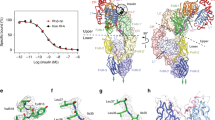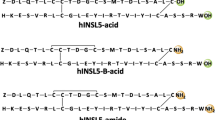Abstract
Two analogs of sheep insulin, both differing from the native material by a single amino acid in the A chain, have been synthesized and isolated in highly purified form by procedures developed in this laboratory. In one case, the glutamine residue in position A5 was replaced by leucine ([Leu5-A]); in the other, the tyrosine residue in position A19 was replaced by phenylalanine ([Phe19-A]). The biological behavior of these analogs was compared with natural bovine insulin inin vitro tests and in receptor-binding assays, as well as in radioimmunoassay. In the stimulation of glucose oxidation by rat adipocytes, the analogs gave relative potencies of 30% and 7.8% for [Leu5-A] and [Phe19-A], respectively. Receptor-binding assays in rat liver plasma membranes showed similar behavior for both analogs. In radioimmunoassay, [Leu5-A] displayed a relative potency of 27.9%, while [Phe19-A] showed a relative potency of 19–27%, compared with bovine insulin. At high concentration, both analogs displayed the same maximal activity as bovine insulin, and the dose-response curves are essentially parallel. It is speculated that the interaction between the glutamine residue in position 5 and the tyrosine residue in position 19 of the A chain of insulin are important in maintaining a three-dimensional structure commensurate with high biological activity. The full intrinsic activity of both analogs at high concentrations and the similarity of the potency figures in receptor-binding and glucose-oxidation assays permit the further conclusion that the reduced potency in the latter assay can be ascribed wholly to the reduced binding affinity toward insulin receptors caused by the substitutions made in the analogs. The receptor-analog complexes are fully capable of triggering the next event in the chain leading to the biological response.
Similar content being viewed by others
References
Blundell, T., Dodson, G., Hodgkin, D. C., and Mercola, E. (1972).Adv. Protein Chem. 26, 279–402.
Bodanszky, M. and du Vigneaud, V. (1959).J. Am. Chem. Soc. 81, 6072–6075.
Bodanszky, M., Denning, G. S., and du Vigneaud, V. (1963).Biochem. Prep. 10, 122–215.
Brown, G., Sanger, F., and Kitai, R. (1955).Biochem. J. 60, 556–565.
Burke, G. T., Chanley, J. D., Okada, Y., Cosmatos, A., Ferderigos, N., and Katsoyannis, P. G. (1980).Biochemistry 19, 4547–4556.
Cosmatos, A., Cheng, K., Okada, Y., and Katsoyannis, P. G. (1978).J. Biol. Chem. 253, 6586–6590.
Danho, W., Sasaki, A., Büllesbach, E., Föhles, T., and Gattner, H.-G. (1980a).Hoppe-Seyler's Z. Physiol. Chem. 361, 735–746.
Danho, W., Sasaki, A., Büllesbach, E., Gattner, H.-G., and Wollmer, A. (1980b).Hoppe-Seyler's Z. Physiol. Chem. 361, 747–754.
Ferderigos, N., Cosmatos, A., Ferderigos, A., and Katsoyannis, P. G. (1979).Int. J. Peptide Protein Res. 13, 43–53.
Gilman, A., Philips, F. S., and Koelle, E. S. (1946).Am. J. Physiol. 146, 348–357.
Gliemann, J., Sonne, O., Linde, S., and Hansen, B. (1979).Biochem. Biophys. Res. Commun. 87, 1183–1190.
Hales, C. N. and Randle, P. J. (1963).Biochem. J. 88, 137–146.
Katsoyannis, P. G. and Schwartz, G. (1977). In Hirs, C. H. W., and Timasheff, S. N. (eds.),Methods in Enzymology, Vol. 47, Part E, Academic, New York, pp. 501–578.
Katsoyannis, P. G. and Tometsko, A. (1966).Proc. Natl. Acad. Sci. USA 55, 1554–1561.in Enzymology, Vol. 47, Part E, Academic, New York, pp. 501–578.
Katsoyannis, P. G., and Tometsko, A. (1966).Proc. Natl. Acad. Sci. USA 55, 1554–1561.
Katsoyannis, P. G., Tometsko, A., and Zalut, C. (1966a).J. Am. Chem. Soc. 88, 5618–5621.
Katsoyannis, P. G., Tometsko, A., and Zalut, C. (1966b).J. Am. Chem. Soc. 88, 5622–5625.
Katsoyannis, P. G., Tometsko, A., Zalut, C., and Fukuda, K. (1966c)J. Am. Chem. Soc. 88, 5625–5635.
Katsoyannis, P. G., Tometsko, A., Zalut, C., Johnson, S., and Trakatellis, A. C. (1967a).Biochemistry 6, 2635–2642.
Katsoyannis, P. G., Trakatellis, A. C., Johnson, S., Zalut, C., and Schwartz, G. (1967b).Biochemistry 6, 2642–2655.
Katsoyannis, P. G., Trakatellis, A. C., Zalut, C., Johnson, S., Tometsko, A., Schwartz, G., and Ginos, J. (1967c).Biochemistry 6, 2656–2668.
Katsoyannis, P. G., Okada, Y., and Zalut, C. (1973).Biochemistry 12, 2516–2524.
Linde, S. and Hansen, B. (1980).Int. J. Peptide Protein Res. 15, 495–502.
Lowry, O. H., Rosebrough, N. J., Farr, A. L., and Randall, R. J. (1951).J. Biol. Chem. 193, 265–275.
Marshall, G. R. and Merrifield, R. B. (1965).Biochemistry 4, 2394–2401.
Okada, Y. and Katsoyannis, P. G. (1975).J. Am. Chem. Soc. 97, 4366–4372.
Okada, Y., Chanley, J. D., Burke, G. T., and Katsoyannis, P. G. (1981).Hoppe-Seyler's Z. Physiol. Chem. 362, 629–638.
Pfleiderer, G., Celliers, P. G., Stanulovich, M., Wachsmuth, E. D., Determann, H., and Braunitzer, G. (1964).Biochem. Z. 340, 552–564.
Pullen, R. A., Lindsay, D. G., Wood, S. P., Tickle, I. J., Blundell, T. L., Wollmer, A., Krail, G., Brandenburg, D., Zahn, H., Gliemann, J., and Gammeltoft, S. (1976).Nature 259, 369–373.
Rodbell, M. (1964).J. Biol. Chem. 239, 375–380.
Sandrin, E. and Boissonnas, R. A. (1963).Helv. Chim. Acta 46, 1637–1669.
Sanger, F. and Tuppy, H. (1951a).Biochem. J. 49, 463–481.
Sanger, F. and Tuppy, H. (1951b).Biochem. J. 49, 481–490.
Schwartz, G., Burke, G. T., and Katsoyannis, P. G. (1981).Int. J. Peptide Protein Res. 17, 243–255.
Schwartz, G., Burke, G. T., and Katsoyannis, P. G. (1982).J. Protein Chem. 1, 177–189.
Spackman, D. H., Stein, W. H., and Moore, S. (1958).Anal. Chem. 30, 1190–1206.
Tometsko, A. and Delihas, N. (1967).Anal. Biochem. 18, 72–80.
Vogler, K., Studer, R. O., Lanz, P., Lergier, W., and Böhni, W. (1965).Helv. Chim. Acta 48, 1161–1177.
Zahn, H., Danho, W., and Gutte, B. (1966).Z. Naturforsch. 21b, 763–773.
Author information
Authors and Affiliations
Additional information
For the previous papers in this series, see Schwartzet al. (1982). Abbreviations: CM, carboxymethyl; tlc, thin-layer chromatography; DMF, dimethylformamide; DMSO, dimethylsulfoxide; Z, benzyloxycarbonyl; Bzl, benzyl; NBzl,p-nitrobenzyl; Boc, tert-butoxycarbonyl; But, tert-butyl; Me, methyl; Np,p-nitrophenyl; TEA, triethylamine; TFA, trifluoroacetic acid.
Rights and permissions
About this article
Cite this article
Ferderigos, N., Burke, G.T., Kitagawa, K. et al. The effect of modifications of the A5 and A19 amino acid residues on the biological activity of insulin. [Leu5-A] and [Phe19-A] sheep insulins. J Protein Chem 2, 147–170 (1983). https://doi.org/10.1007/BF01025378
Received:
Published:
Issue Date:
DOI: https://doi.org/10.1007/BF01025378




